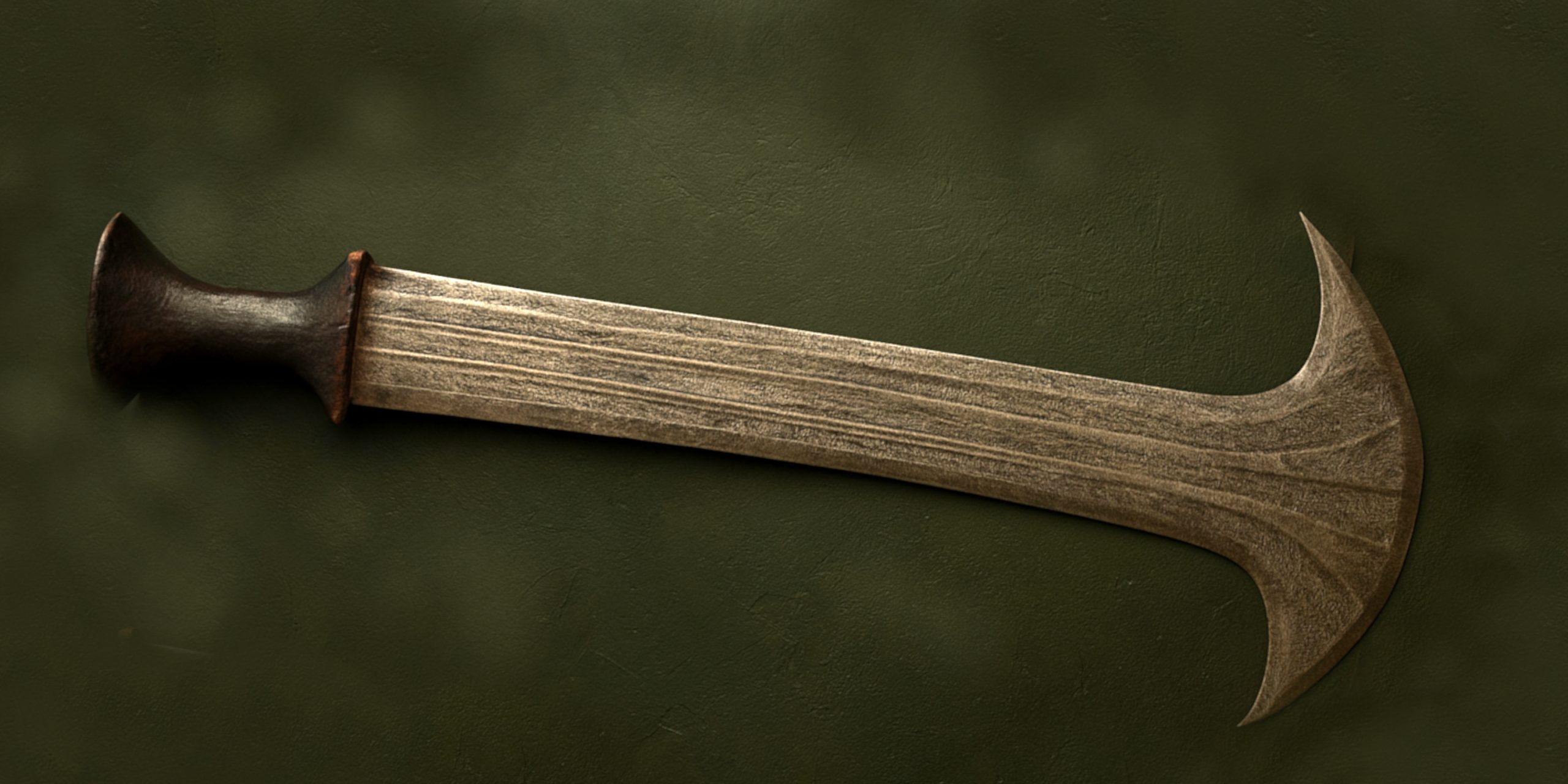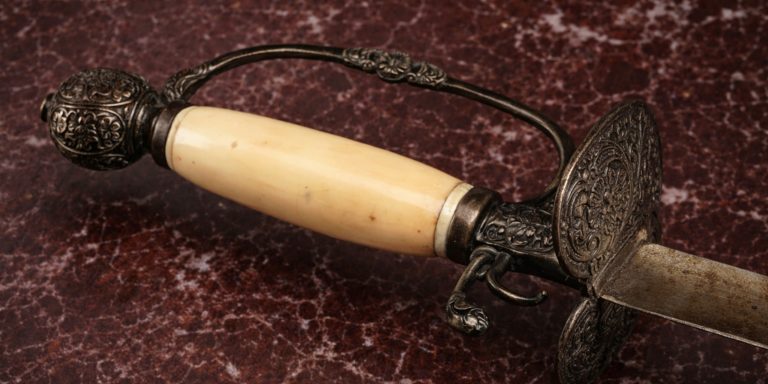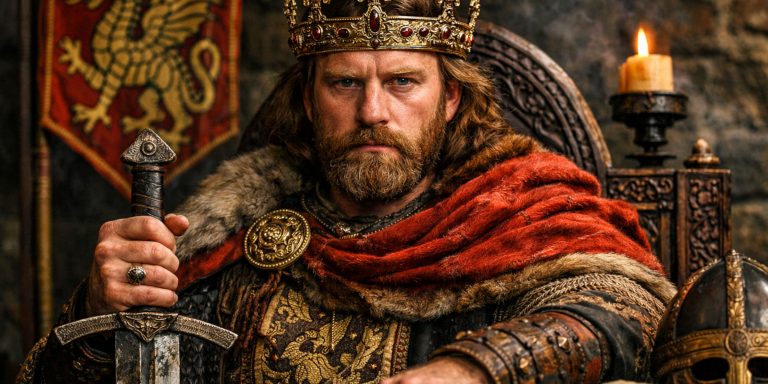
The Luba Prestige Sword is a ceremonial weapon from Central Africa, traditionally used by the Luba people of what is now the Democratic Republic of Congo. Unlike battlefield weapons, this blade symbolised authority, prestige, and artistic refinement within the Luba court system. Its form, often intricate and symbolic, reflected both craftsmanship and the social hierarchy of its owner.
These swords were not designed for combat but rather as emblems of power, held by chiefs, nobles, or dignitaries during important ceremonies. The combination of sculpted metal, ornate pommels, and elegant geometry make each example a work of functional art.
Specification
| Feature | Details |
|---|---|
| Origin | Luba Kingdom, Democratic Republic of Congo |
| Date Range | 18th to 19th century (with some earlier roots) |
| Primary Function | Ceremonial and symbolic weapon |
| Materials | Forged iron blade, copper or brass embellishments, wood or ivory handle |
| Blade Type | Short, flared or leaf-shaped blade |
| Length | Typically 30–50 cm |
| Grip Design | Often wrapped in metal wire or adorned with geometric motifs |
| Decorative Elements | Engraved surfaces, repoussé work, or inset metals representing rank |
History and Evolution
- The Luba people were part of a centralised political and cultural system that flourished between the 16th and 19th centuries.
- Weapons of prestige, including swords, knives, and sceptres, became powerful visual markers of leadership.
- Early Luba blades were simple in form, later evolving into richly ornamented pieces as metallurgy advanced and artistic exchange grew with neighbouring groups such as the Songye and Kuba.
- The prestige sword became an integral part of coronation rituals and public appearances, often paired with other regalia such as sceptres, stools, and decorated calabashes.
- By the late 19th century, colonial collectors and explorers began acquiring these weapons, recognising their aesthetic and anthropological importance.
Advantages and Disadvantages
| Advantages | Disadvantages |
|---|---|
| Visually striking, serving as a symbol of authority and refinement. | Not suitable for practical combat or defence. |
| High craftsmanship showcasing the skill of Luba metalworkers. | Fragile or delicate in heavily decorated examples. |
| Strong anthropological and cultural value for collectors and museums. | Authentic pieces can be difficult to verify due to reproductions. |
| Compact and portable for ceremonial use. | Market availability is limited, driving prices upward. |
Comparison with Similar Weapons
| Weapon | Culture/Origin | Primary Function | Comparison Notes |
|---|---|---|---|
| Ngbandi Knife (Execution Sword) | Central African | Ceremonial and punitive | Larger and heavier, used for ritual executions rather than prestige display. |
| Konda Sword | Mongo people (DRC) | Ceremonial and symbolic | Shares a similar function but features broader blades and less intricate handles. |
| Azande Throwing Knife | Azande (Central Africa) | Combat and display | Designed for throwing or display, unlike the purely ceremonial Luba prestige sword. |
| Kuba Ikula Knife | Kuba Kingdom | Prestige and gift exchange | Comparable in symbolism, with greater geometric blade variety and copper ornamentation. |
Legacy
The Luba Prestige Sword stands today as a key expression of Central African artistry and royal symbolism. Its intricate design represents not only aesthetic mastery but also social identity and governance within the Luba empire.
Modern collectors and museums recognise these pieces as essential in understanding African political iconography and ceremonial practice. They represent a visual language of hierarchy that parallels the regalia of European or Asian courts of the same period.
Where to See
| Institution | Location | Notes |
|---|---|---|
| Royal Museum for Central Africa | Tervuren, Belgium | Holds several Luba prestige swords collected during the colonial period. |
| Metropolitan Museum of Art | New York, USA | Features ceremonial blades from the Luba and neighbouring cultures. |
| Musée du Quai Branly | Paris, France | Displays prestige weapons with detailed documentation on Luba symbology. |
| British Museum | London, UK | Exhibits Central African blades and tools as part of its ethnographic collection. |
Collectors Guide
Collecting Tips
- Authenticity: Genuine pieces often show balanced wear, fine hammering marks, and patina consistent with age.
- Provenance: Documentation tracing the sword’s acquisition through early collectors or museums adds significant value.
- Craftsmanship: Look for refined symmetry, delicate engraving, and quality of metalwork rather than mere shine.
- Condition: Avoid over-polished examples that may have lost original surface details.
Auction Prices
| Auction House | Year | Hammer Price (GBP) | Notes |
|---|---|---|---|
| Sotheby’s, Paris | 2023 | £2,800 | Finely decorated iron blade with copper inlays. |
| Bonhams, London | 2021 | £1,950 | Ivory-hilted example with geometric engravings. |
| Christie’s, New York | 2019 | £3,200 | Early 19th-century piece with strong provenance. |
| Regional African Art Sale (Belgium) | 2024 | £1,400 | Slightly damaged but original ceremonial sword. |
Market Overview
- Average price range for authentic examples: £1,500–£3,500 depending on condition and provenance.
- Reproductions or tourist versions typically sell for under £300.
- Museum-quality examples, especially with ivory or intricate repoussé, can exceed £5,000.
The Seven Swords Takeaway
The Luba Prestige Sword embodies the ceremonial grandeur of Central Africa’s Luba Kingdom, uniting artistry and authority in one symbolic object. Its non-combative design reflects the cultural sophistication of a society that valued representation and order over warfare.
For collectors and historians alike, it remains an enduring testament to how beauty and power were forged not on the battlefield, but in the rituals that defined a civilisation’s identity.



